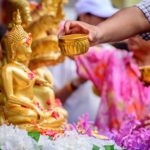Songkran, Thailand’s vibrant New Year celebration, is a three-day festival filled with tradition, energy, and nationwide revelry. Often compared to New Year’s Eve in Times Square, but far more immersive, Songkran transforms streets into massive water fights, bringing entire cities to life. This festival spans from April 13th to 15th, blending ancient customs with modern-day festivities.
Recognized by UNESCO in 2023 as an intangible cultural heritage, Songkran is deeply rooted in Thai culture. Beyond the exhilarating street-wide water fights, it carries deep spiritual significance, incorporating religious ceremonies, family gatherings, and local traditions. Across Thailand, from small villages to bustling cities, Songkran is as cherished as Christmas in other parts of the world, evolving while preserving its core values.
As April is one of Thailand’s hottest months, the water fights provide both a refreshing escape from the heat and a symbolic cleansing to welcome the new year. Whether through street parties, foam parties, or electrifying music-filled celebrations, Songkran remains one of the most joyous and unifying events in Thailand’s cultural calendar.
Songkran Traditions
While the water festival is the most famous element of Songkran, one of the lesser-known traditions is spring cleaning. People prepare for the new year by cleaning their homes, temples, and other public spaces. Communities then join together to promote local festivals, including parades, Muay Thai fights, concerts, and Buddhist rituals at the temple.
While people would wake up early to make merit, offer alms, and listen to the monk’s chant, temple-goers during Songkran will also bring something unexpected: sand. Throughout the year, earth and soil get trudged away from the temple grounds as worshippers come and go. Songkran is also the time to replenish that by creating sand sculptures in the shape of Buddhist stupas decorated with colorful flags. Scented water will also be poured onto Buddhist statues, representing cleansing and good fortune.
At home, families will join together to pour water on the hands and shoulders of elders, offering flower garlands and even gifts of money or fruit.
Besides the religious and cultural traditions, Songkran is also about having fun. Nationwide water fights have evolved into sudsy block parties with super soakers. There isn’t a village in Thailand that isn’t splashing water around.
You’ll also notice people gently applying a white paste to each other’s cheeks. It symbolizes purification and good luck—and is just a playful tradition. In the past, the paste was made from a type of clay that could be scented with aromatics or perfumed water. For convenience’s sake, the paste is usually a mix of baby powder and water.
Songkran, Thailand’s beloved New Year festival, is a vibrant and energetic celebration transforming cities into amazing water fights. While getting swept up in the excitement is easy, understanding Songkran etiquette is essential to ensure a respectful and enjoyable experience.
Do: Be Prepared to Get Wet
If you’re joining the celebrations, expect to be drenched. Water fights are the heart of Songkran, so come prepared:
- Waterproof phone sleeve – A must-have to keep your devices safe. These are inexpensive and widely available.
- Stay hydrated – The festival takes place in April, one of Thailand’s hottest months. Drink plenty of water to avoid dehydration.
- Wear appropriate clothing – Swimsuits are for the beach, not the streets. Opt for light, quick-drying clothing that covers your shoulders and knees out of respect for local customs.
- Sun protection – Don’t underestimate the Thai sun! Apply sunscreen regularly and wear a hat to stay cool.
Don’t: Disregard Songkran Water Fight Etiquette
While the water battles may seem like all-out chaos, there are unspoken rules to follow:
- Avoid splashing monks, the elderly, and young children – This is highly disrespectful.
- Don’t aim for the face – Spraying water at close range or throwing water on motorcycles can be dangerous.
- Respect personal boundaries – Keep the fun lighthearted and friendly. Overly aggressive behavior is not in the festival’s spirit.
Do: Celebrate in Designated Areas
Not every street is part of the festival!
- Most towns designate specific areas for Songkran celebrations, so stick to official water fight zones.
- Avoid throwing water in residential areas or on unsuspecting passersby who may not participate.
- When in doubt, observe the locals—they know the best places to celebrate and the right way to join.
Songkran is more than just an exciting water festival—it’s a cherished cultural tradition that welcomes the Thai New Year with joy and renewal. By following these simple dos and don’ts, you can fully enjoy the festivities while showing respect for Thai customs.
Best Places to Celebrate
One of the best things about Songkran is that no matter where you are in Thailand, you’re guaranteed an exciting and unforgettable celebration. When planning your trip, consider the type of experience you want—whether it’s a high-energy festival, a beachside party, or a cultural immersion, these destinations offer something unique for every traveler.
Buri Ram – A High-Octane Songkran Experience
Looking for a Songkran celebration with an edge? Head to Buri Ram in the heart of Isaan, home to Chang Arena and Buriram United Football Club. This city hosts one of the largest Songkran festivals in the region, where massive water fights meet Muay Thai matches, concerts, and even motorsports. Beyond the main festival at Chang Arena, you’ll see locals celebrating in the back of their pickup trucks, splashing water as they cruise through town. Buri Ram perfectly blends traditional and modern Songkran festivities, offering a fresh twist on the beloved holiday.
Chiang Mai – The Ultimate Songkran Celebration
If you’re looking for a true cultural and festive Songkran experience, Chiang Mai is the place to be. The city takes Songkran to the next level with a 10-day-long celebration, far exceeding the standard three-day festival. The famous Tha Pae Gate becomes the heart of the action, where locals and tourists come together for lively water fights against the backdrop of Chiang Mai’s historic charm. Beyond the playful battles, Songkran here is deeply spiritual—visiting Chiang Mai’s ancient temples allows travelers to witness traditional water-pouring ceremonies and merit-making rituals that reflect the true essence of the Thai New Year.
Chiang Rai – A Cultural and Scenic Songkran Escape
Chiang Rai offers a refreshing alternative for those looking to enjoy a more relaxed yet vibrant Songkran. While you’ll still find exciting water fights, the city’s celebrations emphasize local traditions, including temple visits, cultural performances, and community gatherings. Songkran in Chiang Rai is also scenic, with its celebrations often set against lush mountain landscapes and along the tranquil Kok River. Visitors can participate in Buddhist rituals at Wat Rong Khun (the White Temple) or explore local markets and night bazaars, where festive energy fills the air.
Phuket – Songkran by the Sea
If your idea of the perfect Songkran involves sun, sand, and sea, Phuket is your ultimate destination. Home to some of the wildest and most intense water fights in Thailand, Songkran on Patong Beach turns into a massive block party. Bangla Road becomes a splash zone filled with revelers armed with water guns, creating an electrifying festival atmosphere. For those seeking a balance of fun and tradition, Phuket also hosts cultural Songkran ceremonies and parades—be sure to check with your hotel for nearby local events.
Wherever you choose to celebrate, Songkran is an experience like no other—whether embracing its cultural roots, joining epic water fights, or enjoying a scenic escape, each destination offers something unique. Which one will you choose?





